
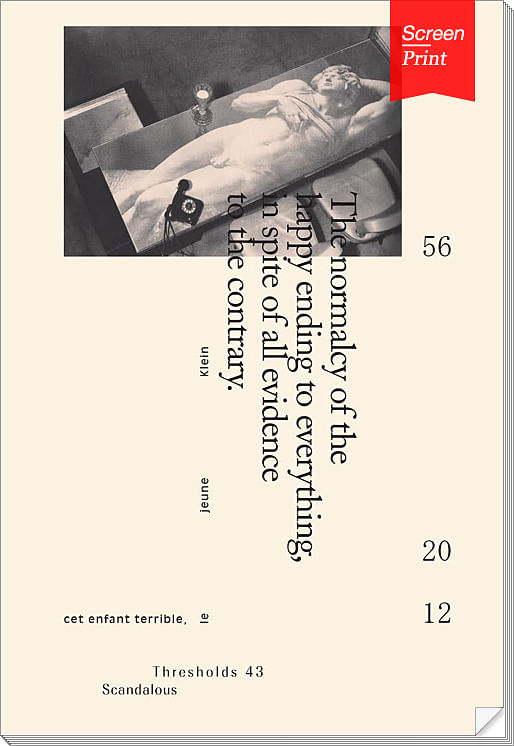
MIT’s Department of Architecture is the oldest in the US, and its journal is comparably formidable. Known as Thresholds, the peer-reviewed publication is issued annually, and not uncommonly features work by established leaders in architectural thought, associated with the school or not. It doesn’t strive towards a single theoretical or conceptual framework as a whole, but unpacks a particular idea with each issue – featured here is “Scandalous”.
Thresholds 43: “Scandalous” knows a good story. Peeking behind the curtain and shining light on what was once hidden away, the issue explores the reverberations that scandalous events can have on creative pursuits. Not limited to architectural scoops, the issue also considers ignominious events in art and culture. In the 24-7 public shaming machine made possible by the internet, scandals can work to both uplift and destroy lives, depending on the mob’s judiciousness. But whether delivered by Twitter or tabloid, scandals make stark relief of the day’s concerns.
An additional element of “Scandalous” that is too neat to ignore is its riff on the physical format of the tabloid. In the parlance of printed newspapers, “above the fold” content referred to the meatiest content, published on the top half of the broadsheet, to catch the reader’s eye as quickly as possible. To this effect, the print version of “Scandalous” starts each article in the first half of the journal, and finishes them in the second half – so that each full spread has different articles on either page. Each scandal is meatier than the next, depending on how you hold it.
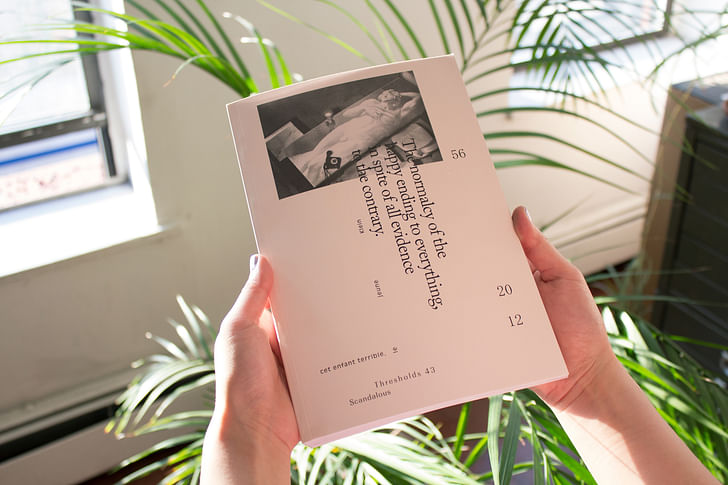
Our Screen/Print scandal is one for the history books – literally. Nora Wendl’s “Uncompromising Reasons for Going West: A Story of Sex and Real Estate, Reconsidered” turns the definitive history of the Farnsworth House on its head, by uncovering the real scandal behind the characterization of the house’s namesake, Dr. Edith Farnsworth. By the time Mies van der Rohe’s iconic design was realized, the relationship between architect and client had gone from one of mutually respecting friends to resentful combatants in a lawsuit over inflated fees. Wendl picks apart the only thorough history of the House, which paints Farnsworth as a dowdy, single older woman, who wanted Mies not only as her architect, but for herself. With this juicy backstory, the lawsuit is cast as a casualty of romantic, rather than architectural, dissatisfaction, discrediting all of Farnsworth’s criticisms of the house. Wendl’s piece takes critical and deeply-researched care unpacking the anti-feminist assumptions behind this characterization, and the non-effect this has had on the House’s prominent role in architectural history of the 20th century. And in doing so, it throws a seemingly invincible architectural icon to the lions (the House, not Mies).
This may perhaps be our longest excerpt featured in Screen/Print so far, but it’s absolutely worth reading every word. For anyone crying scandal, they too may be committing their own – even if it takes over half a century to uncover.
[Endnotes for the following piece can be found in the image gallery at the end of the feature.]
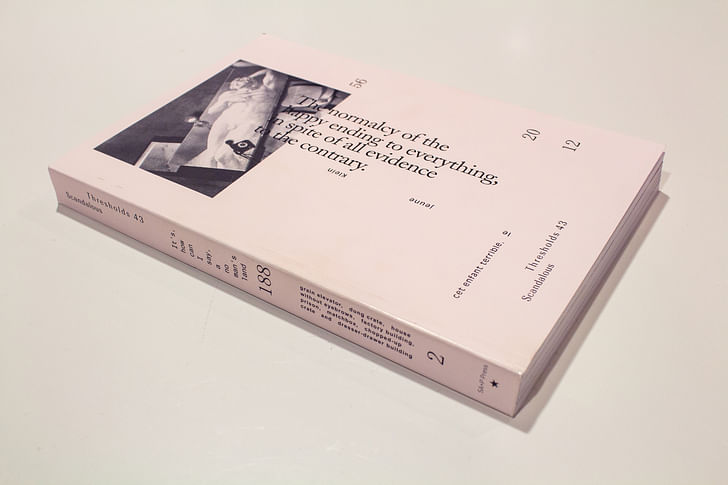

Uncompromising Reasons for Going West: A Story of Sex and Real Estate, Reconsidered
by Nora Wendl
“I have decided to speak up.”Something is rotten in the state of design—and it is spoiling some of our best efforts in modern living.
Such is the threshold between a private affair and a public scandal: one person speaks. These are also the opening lines to “The Threat to the Next America,” which appears in the April 1953 issue of House Beautiful. Penned by editor Elizabeth Gordon, the article describes an unnamed, but “highly intelligent, now disillusioned, woman who spent more than $70,000 building a 1-room house that is nothing but a glass cage on stilts.”[1] Gordon warns readers of a design movement sweeping the nation:
Something is rotten in the state of design—and it is spoiling some of our best efforts in modern living. After watching it for several years, after meeting it with silence, House Beautiful has decided to speak out and appeal to your common sense, because it is common sense that is mostly under attack. Two ways of life stretch before us. One leads to the richness of variety, to comfort and beauty. The other, the one we want fully to expose to you, retreats to poverty and unlivability. Worst of all, it contains the threat of cultural dictatorship.[2]

The subject of her article is the Farnsworth House, designed by Mies van der Rohe for Dr. Edith Farnsworth in rural Plano, Illinois (1946-51). Though Farnsworth is not named here, this article contains statements and concerns that Farnsworth would share with media outlets a legal dispute between her and Mies played out in a “steamy little courtroom” in Yorkville, Illinoiswhile a legal dispute between her and Mies played out in a “steamy little courtroom” in Yorkville, Illinois.[3] Mies sued Farnsworth for an outstanding construction cost of $3,673.09, in addition to fees of $15,000 and $12,000 for architect’s and supervisory services—regardless of the fact that there was no contract between the two that would have upheld the cost of fees. Farnsworth countersued on the basis of fraud, claiming that the architect had misrepresented the cost of the house to her, as well as his abilities as an architect, and demanded he return $33,872.10, the amount she had paid above the original estimate.[4] Her interviews with House Beautiful and the Chicago Daily Tribune were well-timed to this end, their gripping headlines suggestive of an exposé—“Charges Famed Architect with Fraud, Deceit,” and, as framed by Newsweek, “Glass House Stones.”[5]
In an article entitled “Report on the Battle between Good and Bad Modern Houses” in the following issue of House Beautiful (May 1953), Joseph A. Barry foregrounds a conversation with Farnsworth with a simple and provocative question: “How about the ‘individual human being’ in question? How about Dr. Farnsworth herself on the subject of her own house?”[6] Farnsworth answers clearly:
Do I feel implacable calm?...The truth is that in this house with its four walls of glass I feel like a prowling animal, always on the alert. I am always restless. Even in the evening. I feel like a sentinel on guard day and night. I can rarely stretch out and relax…
What else? I don’t keep a garbage can under my sink. Do you know why? Because you can see the whole ‘kitchen’ from the road on the way in here and the can would spoil the The truth is that in this house with its four walls of glass I feel like a prowling animal, always on the alert. I am always restless.appearance of the whole house. So I hide it in the closet farther down from the sink. Mies talks about his ‘free space’: but his space is very fixed. I can’t even put a clothes hanger in my house without considering how it affects everything from the outside. Any arrangement of furniture becomes a major problem, because the house is transparent, like an X-ray.[7]
These graphic descriptions of life in a glass house are rich with visual description, the language reflecting who Farnsworth was—a versed and intelligent physician and researcher of nephrology who also held a degree in English Literature and Composition from The University of Chicago. If these articles in House Beautiful were scandalous to a wider public when they were first published sixty years ago because they played upon the fears of a McCarthy-era America—Elizabeth Gordon warned readers against the rising tide of a ‘cult of austerity’ made evident by the glass house—the articles are scandalous today because they disrupt the narrative of the canonical Farnsworth House, largely considered the only house of note that Mies would complete in the United States.
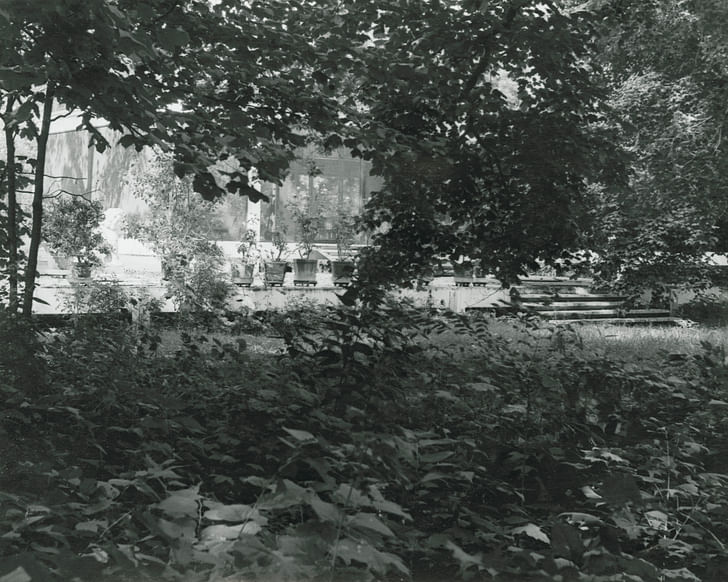
Farnsworth refutes the historical, canonical narrative of the Farnsworth House. She would continue to author such sentiments as appear in House Beautiful when she wrote her unpublished memoirs in the 1970s, upon retiring to Italy after selling the Farnsworth House. Held in the Inventory of the Edith Farnsworth Papers (1900-1977) at the Newberry Library, her memoirs take the form of a series of notebooks filled with the tangled handwriting of a woman in her 70s; folders full of poems she authored, endless correspondence, and photographs of the glass house in a decidedly un-Miesian state all collected in three boxes and one oversized box.
Farnsworth refutes the historical, canonical narrative of the Farnsworth House
However, despite its richness, Dr. Farnsworth’s archive has been only selectively utilized as a primary source on the history of the house. In fact, historians Franz Schulze, Maritz Vandenberg and even Alice T. Friedman, who authors the first (and only) in-depth and beautifully researched account of Farnsworth’s agency in the realization of the Farnsworth House, all highlight in their accounts one particular line from Chapter Eleven of Farnsworth’s memoirs, a statement in which she describes meeting Mies for the first time at a dinner party: “The effect was tremendous, like a storm, a flood, or other act of God.”[8] Here, Farnsworth is awkwardly cast as the breathless and possibly infatuated single woman client of the great architect. However, a preceding sentence contextualizes and clarifies Farnsworth’s awe: “The response was the most dramatic for having been preceded by two hours of [Mies’] unbroken silence. ‘I would love to build any kind of house for you.’”[9]
The effect was tremendous, like a storm, a flood, or other act of God."The selective use of Farnsworth’s memoirs allows the subtle construction of the historical narrative that Farnsworth did not publicly lambast the house because it had any legitimate flaws, but because she was heartbroken not to have acquired the architect alongside it: a “failed romance,” in Vandenberg’s words.[10] This theory of failed romance appears for the first time in Franz Schulze’s Mies van der Rohe: A Critical Biography (1985). As this is a history of the house in the larger context of a biography of the architect, the social aspects of the history become primary—in particular the soured relationship between client and architect. “Most witnesses to the Mies-Farnsworth friendship agree that it was a romance of some sort for a time, yet proof of the extent of it is lacking,” Schulze writes.[11] Such a possibility is a compelling story, and it diverted attention away from the potential problems of the house, as outlined by Farnsworth herself in House Beautiful, and toward the relationship between client and architect: “Technically at issue [in the legal conflict between Farnsworth and Mies] was the question of who owed what to whom for the unexpectedly high cost of the house…the real struggle, however, was over bigger stakes. It was a clash of two personalities of immense force and authority.”[12] As the first historian to grapple with the history of the Farnsworth House, Schulze attends to the subject without the convenience of prior histories. He conducts personal interviews with the employees and remaining family of Mies van der Rohe, mainly his daughters, with Farnsworth’s estranged sister, Marion Carpenter. In an interview with Schulze, Carpenter recalls that: “[Edith] was mesmerized by him and she probably had an affair with him."[13] According to Schulze, others—mainly Mies’ all-male staff—had also speculated upon this possibility. Schulze also includes as evidence a phrase attributed to Mies in an editor’s short response to a letter in Newsweek in 1969: “the lady expected the architect to go along with the house.”[14] The editor hints at no source for this quip.I would love to build any kind of house for you."
But the narrative of failed romance cannot rely on specious evidence alone, so Schulze brings into the discussion the appearance of the client as confirmation. A passport photograph of Dr. Farnsworth, taken in her late 60s, long after this history has occurred, is published alongside the following, cementing the narrative of an unattractive, and therefore romantically disappointed woman whom the architect would understandably reject:
Edith was no beauty. Six feet tall, ungainly of carriage, and, as witnesses agreed, rather equine in features, she was sensitive about her physical person and may very well have compensated for it by cultivating her considerable mental powers. Doubtless it was these that attracted Mies to her in the first place and in turn persuaded her that he was a great talent in his own right.[15]
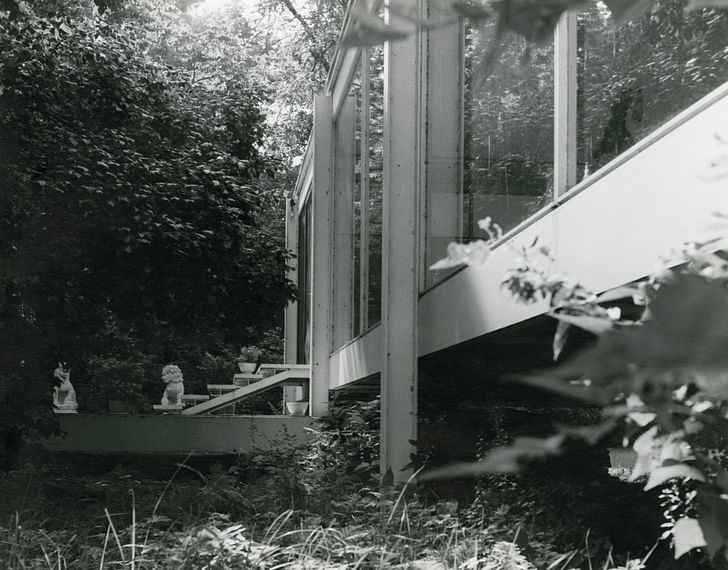
Unfortunately, as the first history of the Farnsworth House, Schulze’s history also becomes the definitive history of the Farnsworth House. No other widely published history of the house emerges for ten years, until Alice T. Friedman’s essay “Domestic Differences: Edith Farnsworth, Mies van der Rohe, and the Gendered Body” (1996).[16] In this history of the house, Friedman turns to Farnsworth’s memoirs, the Mies van der Rohe Archives at the Although it was widely assumed that the two were romantically involved, there is nothing in Farnsworth’s Memoirs to support that contentionMuseum of Modern Art and Mies’ papers at the Library of Congress to construct a history based upon archival accounts. Here, differences become evident and the truth of Farnsworth’s memoirs might be questioned: for instance, Friedman uncovers that Farnsworth claims in her memoirs to have selected Mies through a chance encounter with the architect at a dinner party. In an interview with Myron Goldsmith and according to Schulze, however, she selected him from a list of architects supplied by the Museum of Modern Art.[17] Discrepancies aside, by opening Farnsworth’s memoirs and considering her reflections alongside other historical accounts—referencing Schulze primarily for Mies’ biography, not for an account of the relationship between client and architect—Friedman places Farnsworth’s subjective views alongside other archival sources, legitimizing them as historical evidence, and negating the story of jilted romance: “Although it was widely assumed that the two were romantically involved, there is nothing in Farnsworth’s Memoirs to support that contention,” she writes.[18] However, even Friedman cannot entirely escape the narrative laid out by Schulze. She, too, selects just the partial quote from Farnsworth’s memoirs regarding the evening that the client first meets Mies van der Rohe, characterizing Farnsworth’s impression of the meeting as “… like a storm, a flood or other act of God.”[19]
With the exception of Friedman’s revision to this essay for her Women and the Making of the Modern House: A Social and Architectural History (1998), all successive histories of the Farnsworth House elect to focus not on the potential flaws of the Farnsworth House that Farnsworth outlines—or the potential flaws of the power imbalance of architect-client relations—but rather on the original, baseless story that Farnsworth was heartbroken and vengeful when approaching the press. Franz Schulze, in his 1997 monograph on the house (produced by Dirk Lohan, Mies’ grandson) describes their personal relationship as “inseparable from the The evidence suggests that she yearned to find a friend, not just an architect. Less certain is whether she wanted more than thathistory of the house.”[20] He reminds the reader that Mies, though legally married, had left his wife and family in Europe long before emigrating, leaving potential room for a relationship between the two to flourish: “The evidence suggests that she yearned to find a friend, not just an architect. Less certain is whether she wanted more than that. Did she know that Mies had relationships of a more or less romantic nature with other women during the very years he was working on her house?”[21] In a 2003 monograph on the house, Maritz Vandenberg continues the suggestion of something untoward, writing that “…unfortunately, the initially sympathetic relationship between architect and client had turned sour. Everyone who knew them agrees that this was at least partly due to a failed romance between Mies van der Rohe and Edith Farnsworth.”[22] Vandenberg cites Schulze’s 1985 book as his primary source and he, too, recalls the specious quote attributed to Mies in Newsweek.
The relationship between client and architect informs the headline of William Norwich’s article for the New York Times Style Magazine on June 1, 2003, which appeared announcing the auction of the house via Sotheby’s, perhaps one of the most widely-read contemporary articles on the Farnsworth House: “Sex and Real Estate: Farnsworth House, Mies van der Rohe’s masterpiece, is up for grabs. Along with a Juicy Tale.” And in the most recent historicization of the house, Franz Schulze’s thorough revision to Mies’ biography written in collaboration with Edward Windhorst and published in 2012, the suggestion of an architect-client-house love triangle still exists: “The spectacle was fascinating; two distinguished professionals, both single, socializing and working so closely together as to suggest—what? A dalliance? A romance?”[23]
the story of sex and real estate has replaced any other history of the house.Thus, in even our most contemporary historicizations of the Farnsworth House, the story of sex and real estate has replaced any other history of the house. It is a story in which the experimental and decidedly flawed glass house is left unsullied—and perhaps this is a hint at its origin, a history that began as rumors intended to drown out the bad publicity and public sympathy that Farnsworth’s interviews generated during the infamous trial. This story has stayed present in the minds of many critics and historians who cite even specious references to it—perhaps because it salvages the house’s architectural reputation and because lifting the story of sex and real estate makes it unnecessary to critique the house at all. The ensuing conflict—the scandal of the house—is therefore laid at the feet of its client, a supposedly scorned and vengeful woman. That the prevailing social attitudes toward gender and gender expectations which have emerged in the wake of feminism and postmodernism have not had an effect upon the historicizing of the Farnsworth House, outside of Friedman’s scholarship, reveals a phenomenon that Friedman herself puts best, that “[s]pace and subjectivity (except perhaps that of the architect) are suppressed in favor of a pictorial representation which distorts the subject of inquiry, collapsing the distinction between the building and the representation.”[24] Indeed, even in architectural history—which is one of those representations of architecture—it seems only the subjectivity of the architect is worth upholding.
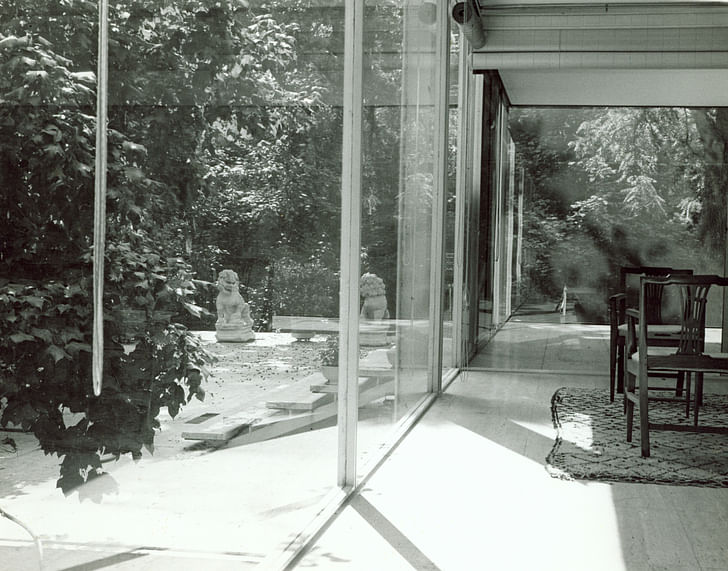
What Farnsworth’s own papers reveal is an alternate history of her relationship with this glass house and its architect—one that cannot be collapsed into a palatable form, and that is far more ambiguous and complex than the story of sex and real estate. Farnsworth’s archive is rich with material, its nuances inaccessible to superficial historical interpretations. It contains four folders of correspondence, fourteen folders of photographs, seventeen folders of her English translations of Italian poetry, two folders of poems she certainly authored and one folder of unidentified poems—unsigned, unattributed to any particular poet and thought perhaps to be authored by Farnsworth. Seven folders hold her memoirs—handwritten in three journals and typed in multiple sheaves of paper—best described by Farnsworth’s sister, Marion Carpenter, in a letter: “I found Edith’s memoirs had such gaps that I was not able to put them in order with any continuity.”[25] In addition to being disordered, Farnsworth’s memoirs are accused of being partly fictitious, not the stuff of history.[26]
While the history of the Farnsworth House has long been located within the context of the relationship between client and architect, it is in Chapter Thirteen of her memoirs that Farnsworth’s relationship with the house itself fully begins:
By the end of 1950, it seemed possible to spend a night in the house, and on New Year’s Eve I brought out a couple of foam mattresses and a number of other indispensible articles and prepared to inhabit the glass house for the first time. With the light of a bare, sixty-watt bulb on an extension cord I made up the foam rubber mattress on the floor, turned up the air furnaces and got something to eat. Spots and strokes of paint remained here and there on the expanses of the glass walls and the sills were covered with ice. The silent meadows outside, white with old and hardened snow, reflected the bleak bulb within, as if the glass house itself were an unshaded bulb of uncalculated watts lighting the winter plains. The telephone rang, shattering the solitary scene.
It was an uneasy night, partly from the novel exposure provided by the uncurtained glass walls and partly from the dread of Mies’ implacable intentions. Expenses in connection with the house had risen far beyond what I had expected or could well afford and the glacial bleakness of that winter night showed very clearly how much more would have to be spent before the place could be made even remotely inhabitable.[27]

This passage of Farnsworth’s memoirs are teeming not only with her uneasiness, but with the ambiguity of the entire situation. The structure is uninhabitable, she writes, and yet she inhabits it for an evening. She has paid a handsome sum—nearly double what she’d originally planned to spend—yet what she’s gained is an uncertain triumph. Certainly, it is an extraordinary house by an architect who has earned international acclaim, but he is still building his career in America. And the house is in a raw state: Farnsworth dreads “Mies’ implacable intentions,” uncertain how to live within them. In the house’s open plan, the relationship between she and a hypothetical guest would be defined by the social contract between them, not by (the non-existent) walls:
…a guest would have a bathroom but no bedroom. He, or she, could sleep on a sofa or I would spread a mattress on the travertine floor. We would cohabit a sort of three-dimensional sketch, I in my “sleeping space” and he in his^ [28]
An abrupt asterisk refers us to a handwritten note on the otherwise blank left page of Farnsworth’s notebook: “^ unless sheer discomfort and depression should drive us together.”[29]
even in architectural history ... it seems only the subjectivity of the architect is worth upholding.
It is possible to imagine that Farnsworth is referring to Mies here, but romantic allusions do not appear elsewhere in her memoirs, where her depictions of the architect are by turns admiring, less-than-flattering and damning. Farnsworth describes visits to the site with him as “great fun,” and Mies’ office as “a club room, a sanctuary and a kibbutz” where “the boys vied for the privilege of contributing to the realization of ‘the most important house in the world.’”[30] Mies and Farnsworth do socialize between 1947 and 1950, and have many conversations about architecture, philosophy, and life—and the difference in their approach to the latter is remarkable. In a desire to understand Mies’ approach to architecture, Farnsworth reads texts by Romano Guardini. She urges him, in return, to read the physicist Erwin Schrödinger’s What is Life? It upsets him, and in her memoirs she records his response:
It is unspiritual. What about man and his hopes for immortality? Does Schroedinger [sic] think I can sit staring at the snowflakes on the window or the salt crystals on the dinner table and be satisfied? I want to know what I have to expect after death.
Her response to Mies, that “even by deleting the questions of the natural longings of human beings for a hereafter,” Schrödinger “still offers to man the very considerable dignity of the observer of life,” is of no use to the architect.[31] The difference in their views strikes her as remarkable, and she writes, “I was struck with the force of Mies’ preoccupation with death and it lent a mystic context even to the project of the house by the river, and an indefinable dimension to the personality of Mies.”[32] The house begins to take on its poetic and transcendent potential.

The 'scandalous' story of a woman scorned stems not from the client’s recollections, then, but from a gender normative, if not entirely sexist, fabricationThe final rift between the client and architect, according to Farnsworth’s memoirs, is logistical. It occurs when Farnsworth argues that a young man from Mies’ office is bothering construction workers with unnecessary questions, thus delaying their progress. Mies responds curtly: “You go back to your nephritis where you belong and leave me to build your house without interference."[33] From this moment forward, her memoirs reflect that Farnsworth is suspicious of the architect and his intentions. Thus, when expenses for the house rise higher than she had anticipated, she takes action:
… I wrote to Mies that I was unable to underwrite any further expenses in connection with the Fox River project. I remember he did not acknowledge my communication either in writing or by word of mouth, and I felt that a refusal to authorize further expenses should not involve a rupture of friendship between us and therefore made efforts to continue all of our cordial customs.[34]
It seems that the only story that cannot be found in Farnsworth’s archive is the story of sex and real estate. The 'scandalous' story of a woman scorned stems not from the client’s recollections, then, but from a gender normative, if not entirely sexist, fabrication: the perception that the only cause for her counter-suit against Mies van der Rohe is a romantic failure, rather than a professional one.
What a deeper and contextual reading of Farnsworth’s memoirs give evidence to is much more nuanced than the fabricated story of a woman’s midlife struggle with unrequited love. Rather, throughout her life, Farnsworth battled the more ambiguous heartbreak of finding a place in the world, and of finding true confidants. The house, and her relationship to it, was to be the beginning of this—“I came to the conclusion that something would have to be done she sought an intellectual equal rather than a romantic partner, and was disillusioned; about those tired, dull Sundays,” she writes in an early passage of her memoirs that precedes her discovery of the stretch of land along the Fox River.[35] Instead of choosing to be a wife and mother, Farnsworth chose to be a physician and academic—a choice that put her at odds with societal expectations of women in the 1940s and 1950s. Her experimental efforts at Northwestern University yielded groundbreaking advances against the kidney disease nephritis. Despite a challenging and prodigious career that deeply engaged her, Farnsworth expressed discomfort: she was quite aware that she existed on the outside of society, while thoroughly questioning the very mores to which she was expected to conform. Her relationship with Mies could also be interpreted this way: she sought an intellectual equal rather than a romantic partner, and was disillusioned; “Perhaps it was never a friend and a collaborator, so to speak, that he wanted,” she writes, “but a dupe and a victim.”[36]
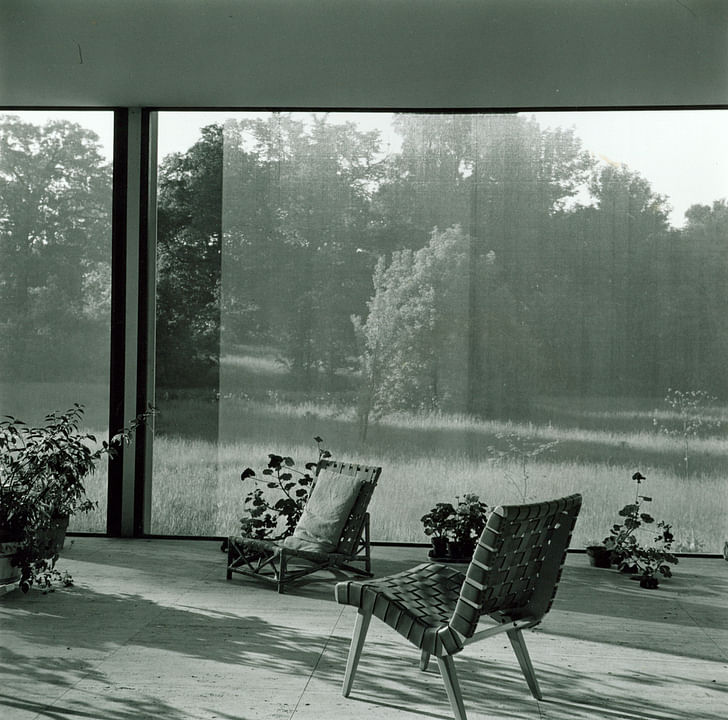
Farnsworth does not only recognize this societal discomfort in herself, but in the patients under her care. She blames this on a cultural zeitgeist of fear that, she writes, “…has come to dominate each human heart, namely, the fear of ostracism, the dread of non-conformity….”[37] In her memoirs, she consoles a patient named John with these words as they stand at her office window:
I suppose you think of all those people down there as normal hence right, and of yourself as abnormal and wrong… But we only see the tops of their heads and their feet, not their suffering or their lost hopes. And as for this normal that we hear so much about and think so highly of—what do you suppose it amounts to? Isn’t it just a rather restricted, superficial zone, arbitrarily and cheaply defined, running through the middle of our collective body, from which strong and deep feelings and creative original ideas are excluded? Remember that our American climate of national optimism and self-righteousness has, until recent years, bred us to the normalcy of the happy ending to everything in spite of all evidence to the contrary.[38]our American climate of national optimism and self-righteousness has, until recent years, bred us to the normalcy of the happy ending to everything in spite of all evidence to the contrary
For Farnsworth, the glass house is—perhaps always was, even in its nascent stages— evidence to the contrary.
I have often thought of the eerie solitude in which I continued that routine drive westward to the glass house on the river. Surely all the rest of the throng had equally uncompromising reasons for going west: wives, kiddies, lawns to be mowed, weeds to be pulled…Hands still clutching the wheel, eyes intent upon the south horizon, were they still advancing in their long lines? [39]
For someone who, we speculate, would have believed that any endings or beginnings—happy or otherwise—are simply narrative constructions that do not reflect the way events unfold in life, Farnsworth maintained an impressive and lifelong commitment to producing art. This was true during her tenure in the house from 1951-1971, where she authored poems and art-directed photographs that provide an immediate translation of her relationship with the glass house.[40] In her photographs, Farnsworth presents a striking portrait of the house: it emerges from a dense forest, as it would have appeared to those who sought it out in the years that she dwelled there. Viewed under these circumstances, it is nearly opaque: the porch is enclosed with aluminum screens to protect against river-borne mosquitoes, and planters line its edges. Wild and exuberant foliage tangles around the iconic steel I-beams, and spider webs nestle in their flanges. The glass walls alternate between transparency and reflecting the trees surrounding them, and branches and leaves litter the travertine terrace. These photographs illustrate Farnsworth’s argument against what she describes as the “violent” dislocation of nature in the late 1950s: “… something has happened to nature…she has become secularized, even domesticated. Today, she rubs her muzzle on the windowpane.”[41] Here, nature is anything but domestic; where the house begins and where nature ends is a line too buried to comprehend. Photographs taken from within evidence the same ambiguity. The interior world of the house is reflected in the glass so that furniture seems to hover spectrally in the field beyond the house. And do we see a reflection of the south façade in the glass of the west façade, or is the wall that appears to continue westward, eventually fading into the trees, actually the infamous addition of aluminum screens to the porch?something has happened to nature…she has become secularized, even domesticated.
One thing is certain: this is not Mies’ beinahe nichts. It is instead the world that Farnsworth, a physician, researcher, poet and violinist, sought—a world beyond the clarity of facts. “When you understand all about the sun and all about the atmosphere and all about the rotation of the earth, you may still miss the radiance of the sunset,” she quotes Alfred North Whitehead in an essay for the Northwestern TriQuarterly.[42] It is the poet’s responsibility, she argues, to return to us the radiance of sunsets—to reach for what is elusive, to manifest beauty.[43] Farnsworth herself sought to participate in the production of beauty in various forms throughout her life: playing violin, and writing and translating poetry. “The purpose of poetry at this time,” she continues, “…is unquestionably the constant redefinition of beauty…”[44]
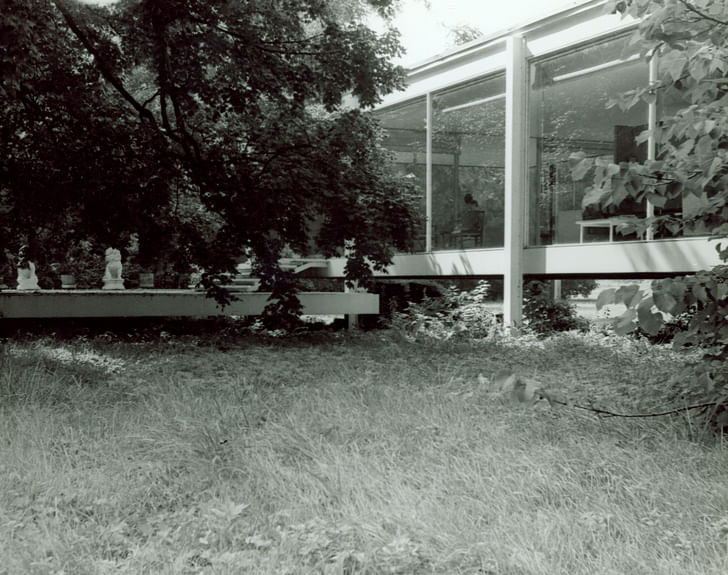
Farnsworth’s poems contribute to this redefinition of beauty—and in them, the loss of and isolation from what she seeks is much more palpable than in the photographs.[45] The glass house appears in these works, but the poems do not focus on describing it, or on the problems that ensue in its realization, nor is the architect mentioned. Rather, the poems meditate upon the transitory events that the house engenders: and the house is no neutral mediator. When a bird strikes the pane of glass near her bed early one morning, its interaction with the house transforms it into a symbol of loss: “The splintered feathers agonize in vain. / The moments pass / And in the grass / Below, there lies / My hope, and dies.” (Fig. 8). In Farnsworth’s poems, the glass house is mutable, and thus unpredictable: its glass walls are not transparent, but “luminous.” As such, they do not connect the inhabitant to the world surrounding her—“I could not see…”—as might be expected, but rather leave her “Secluded by reflection,” and “Windowed by solitary calls”— calls that might coming from within the house, or without (Figure 9). In these poems, Farnsworth occupies the pronoun I, giving no evidence of her physicality or her gender, but waiting, as she writes in “Portrait of an Addict a narrative far more complex than heartbreak over the loss of a rumored lover—it is heartbreak over what is unattainable in any permanence.Soul,” waiting, and waiting for an unspecified beauty, “lain supine / Upon my cell’s floor, below / The window’s sky. / In my own sensorium …” The beauty that she seeks to define does not come, though she maintains a “limitless desire.” Its absence is felt in the deep melancholy that pervades her poems, and in the references to the loss of love—not the loss of romantic love, but the loss of a vision or a creation that required love to sponsor it as she writes in her unpublished poem “With the Leaves”: “November is hardly a month for birth: / The breath of love is too long cold / And the dawn comes late. …. Hardly can I lure the dream / Back to its birth in the creating soul.”
In her photographs and poems, Farnsworth mourns the elusiveness of her initial impulse upon visiting the site: to create a significant and meaningful work of architecture that both resonated with her own desires for finding a place in a world that defined her as simply “Edith Farnsworth: An Unmarried Woman,” and which had broader, cultural appeal—in other words, beauty.[46] That she fails at this, and finds the house uncomfortable, and that its fame burdens her with constant weekend visits, with waking to “skirts fluttering behind trees,” and visitors who “thumbed their way tirelessly aboard my distress” reveals a narrative far more complex than heartbreak over the loss of a rumored lover—it is heartbreak over what is unattainable in any permanence.[47] The radiance of the sunset is, after all, a fleeting beauty. “Humans beings have always needed to transcend their immediate experience,” she writes, “[b]ut how is the transcending to be done?”[48] And perhaps here, Farnsworth reveals the ultimate architectural scandal, the one we know to be true: that our transcendence will require far more than glass, steel, and travertine.

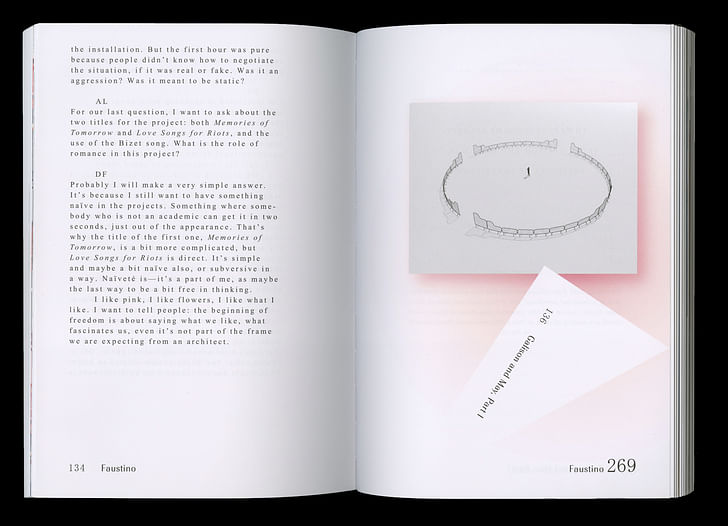
About the author:
Nora Wendl composes architectures and architectural histories by borrowing strategies from the adjacent fields of fiction, poetry, art and literature. She is editor, with Isabelle Loring Wallace, of Contemporary Art About Architecture: A Strange Utility (Ashgate, 2013). Wendl is currently Assistant Professor of Architecture at Portland State University.
Thresholds 43: "Scandalous" is edited by Nathan Friedman and Ann Lui.
Contributors
Cristina Parreño Alonso, Nisa Ari, Austin+Mergold, Jordan Carver, Beatriz Colomina, Jackson Davidow, Sebastiano Fabbrini, fala atelier, Didier Faustino, Peter Galison, Kristen Gaylord, Hans van Houwelingen, Andrés Jaque, Mark Jarzombek, Ang Li, John May, Ruvimbo Moyo, AnnMarie Perl, Doris Sommer, NADAAA, Urbonas Studio, Nora Wendl
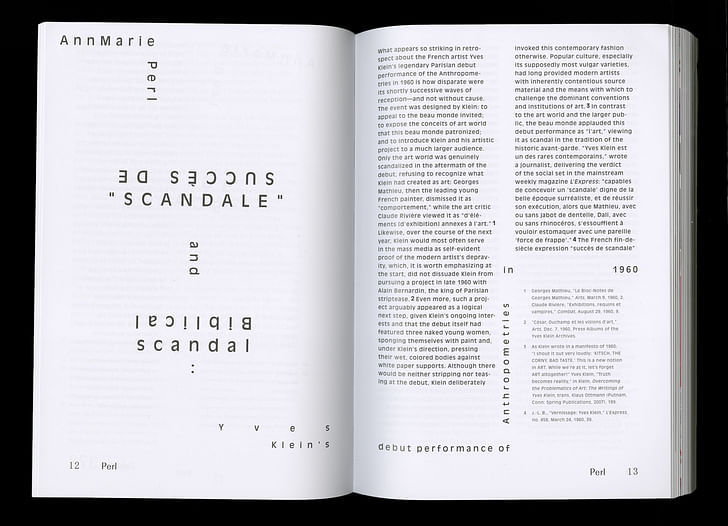
Screen/Print is an experiment in translation across media, featuring a close-up digital look at printed architectural writing. Divorcing content from the physical page, the series lends a new perspective to nuanced architectural thought.
For this issue, we featured Threshold #43: "Scandalous".
Do you run an architectural publication? If you’d like to submit a piece of writing to Screen/Print, please send us a message.
Former Managing Editor and Podcast Co-Producer for Archinect. I write, go to the movies, walk around and listen to the radio. My interests revolve around cognitive urban theory, psycholinguistics and food.Currently freelancing. Be in touch through longhyphen@gmail.com
No Comments
Block this user
Are you sure you want to block this user and hide all related comments throughout the site?
Archinect
This is your first comment on Archinect. Your comment will be visible once approved.